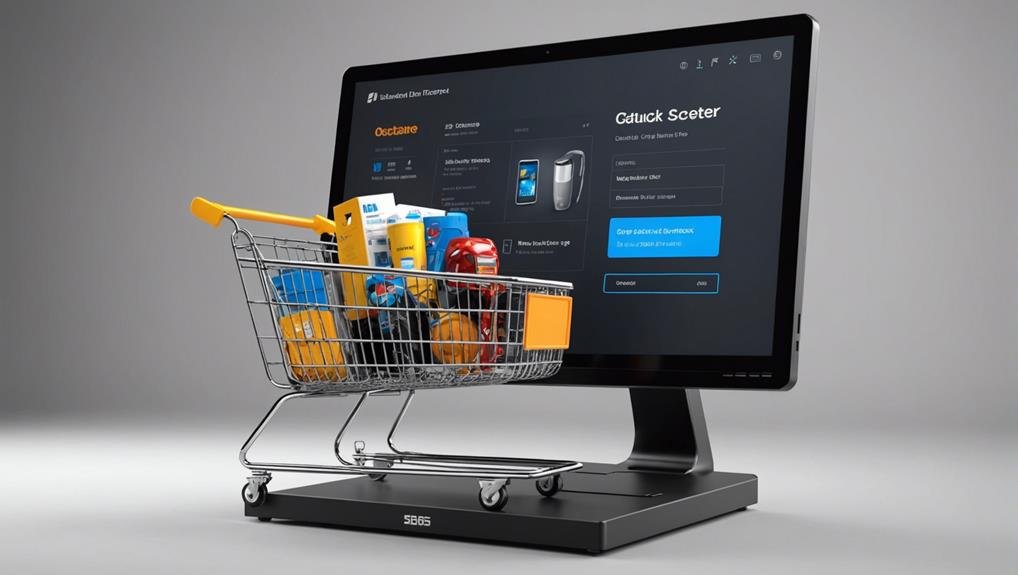Electronic Retailing (e-Tailing): Definition, Types, Examples
E-tailing, or electronic retailing, refers to the online buying and selling of goods and services, transforming traditional commerce in the digital era. It is essential for businesses to grasp consumer behavior and leverage technological advancements like AI for personalization. E-tailing includes Business-to-Consumer (B2C), Business-to-Business (B2B), and Customer-to-Customer (C2C) models, each with distinct customer interaction approaches. Omnichannel methods and subscription services also play a role. Understanding these types is critical for success in the e-commerce landscape. Discover how e-tailing types and strategies can impact your business growth.
Key Takeaways
- E-tailing involves online selling and buying of goods and services.
- Types include B2C, B2B, C2C platforms, dropshipping, and subscription services.
- Examples are Amazon, Alibaba, eBay, Shopify, and Netflix.
- E-tailing utilizes digital platforms for transactions and customer interactions.
- It offers convenience, accessibility, and various pricing and delivery options.
Understanding E-Tailing Fundamentals
The fundamental principles of electronic retailing (e-tailing) serve as the cornerstone for businesses venturing into online sales, shaping their strategies and operations in the digital marketplace. E-tailing heavily relies on understanding consumer behavior to tailor offerings and enhance the shopping experience.
By analyzing consumer preferences, purchase patterns, and feedback, businesses can optimize their online platforms to drive sales and customer satisfaction. Moreover, technological advancements play an essential role in e-tailing success.
Implementing innovative technologies such as AI-driven personalization, seamless payment gateways, and mobile-responsive designs can greatly impact the overall shopping experience and increase conversion rates. Hence, a deep understanding of e-tailing consumer behavior and leveraging cutting-edge technological solutions are essential for businesses to thrive in the competitive online retail landscape.
Exploring E-Tailing Types
Within the domain of electronic retailing (e-tailing), various types of online sales models cater to different business-to-consumer and business-to-business transactions. Business-to-Consumer (B2C) e-tailing involves direct sales to consumers, while Business-to-Business (B2B) e-tailing focuses on transactions between companies.
A comparative analysis of these models reveals distinct approaches to customer interaction, pricing strategies, and supply chain management. Additionally, Customer-to-Customer (C2C) platforms, dropshipping, subscription services, and omnichannel methods contribute to the diverse landscape of e-tailing.
Industry insights suggest that understanding these various types and models is essential for businesses aiming to thrive in the competitive e-commerce environment. By evaluating the strengths and weaknesses of each approach, companies can tailor their strategies to meet consumer demands and stay ahead of market trends.
Evaluating E-Tailing Advantages and Disadvantages
Moving forward from discussing the various types and models in e-tailing, a thorough examination of the advantages and disadvantages of electronic retailing sheds light on its operational dynamics and strategic considerations.
E-tailing offers significant advantages such as lower infrastructure costs, a broader customer reach, automated sales processes, and diverse revenue sources like online advertising and subscriptions. However, it also presents challenges including high website maintenance costs, the absence of sensory experiences that traditional retail provides, and difficulties in maintaining personalized customer relations.
Understanding these pros and cons is essential for e-tailers to navigate the e-tailing landscape effectively and develop strategies that leverage the strengths while addressing the challenges inherent in this digital retail environment.
Analyzing E-Tailing Market Dynamics
Analyzing the intricate market dynamics of e-tailing reveals the essential competitive landscape and consumer behavior trends shaping the digital retail industry. Market trends indicate a shift towards personalized shopping experiences, increased mobile shopping, and the integration of AI technologies for enhanced customer interactions.
Competitive analysis showcases key players like Alibaba and Amazon leading the market with innovative strategies and investments in technology and logistics. The e-tailing market is projected to grow substantially, reaching an estimated $6.54 trillion by 2027.
Understanding these market dynamics is vital for e-tailers to adapt their strategies, stay competitive, and meet the evolving demands of online consumers. By closely monitoring market trends and competitors, e-tailers can position themselves strategically for future success.
Strategizing E-Tailing Marketing Approaches
Crafting effective marketing approaches in e-tailing requires a thorough understanding of consumer behavior, technological advancements, and competitive landscapes to drive successful online sales strategies. Personalized targeting plays a crucial role in tailoring product offerings to individual preferences, enhancing customer engagement and satisfaction.
E-tailers leverage social media outreach to build brand awareness, engage with customers in real-time, and drive traffic to their online platforms. By analyzing consumer data and trends, e-tailers can optimize their marketing strategies, target specific customer segments, and create personalized experiences to boost sales and loyalty.
Embracing digital marketing tools and innovative techniques, such as influencer collaborations and interactive content, can further enhance e-tailers' reach and competitiveness in the dynamic online marketplace.
Conclusion
To sum up, electronic retailing, or e-tailing, has revolutionized the way businesses sell goods and services online. By adapting to changing consumer preferences and leveraging innovative strategies, businesses can thrive in the digital marketplace.
As e-tailing continues to grow, companies must stay informed about market trends and effectively market their products to remain competitive. In the fast-paced world of electronic retailing, staying ahead of the curve is essential to success.
As the saying goes, 'Adapt or perish.'







